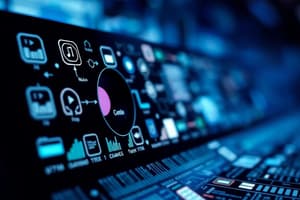Podcast
Questions and Answers
What distinguishes media literacy from general literacy?
What distinguishes media literacy from general literacy?
- Media literacy is the ability to read and write only.
- Media literacy requires extensive knowledge of all forms of technology.
- Media literacy focuses solely on print media.
- Media literacy involves the creation and evaluation of various forms of media. (correct)
Which of the following is NOT a characteristic of misinformation?
Which of the following is NOT a characteristic of misinformation?
- It is often shared unknowingly.
- It is intended to deceive the audience. (correct)
- It can involve a completely false content.
- It may arise from misleading content.
What does technology literacy encompass?
What does technology literacy encompass?
- Exclusive expertise in the latest technological trends.
- Understanding the history of technology development.
- The ability to create complex software programs.
- The ability to use technological tools effectively and appropriately. (correct)
Which of the following best describes the term 'malinformation'?
Which of the following best describes the term 'malinformation'?
What is the significance of understanding the 'false connection' in media?
What is the significance of understanding the 'false connection' in media?
Which of the following illustrates the concept of manipulated content?
Which of the following illustrates the concept of manipulated content?
What is a primary goal of media and information literacy?
What is a primary goal of media and information literacy?
What aspect differentiates disinformation from misinformation?
What aspect differentiates disinformation from misinformation?
What type of media primarily relies on printed materials for communication?
What type of media primarily relies on printed materials for communication?
How do media messages typically reflect their values and viewpoints?
How do media messages typically reflect their values and viewpoints?
Which of the following best describes the function of technical codes in media?
Which of the following best describes the function of technical codes in media?
What is the primary purpose of media conventions?
What is the primary purpose of media conventions?
In the context of media language, what do symbolic codes convey?
In the context of media language, what do symbolic codes convey?
Why might a media message be organized primarily for profit or power?
Why might a media message be organized primarily for profit or power?
Which of the following best defines denotation in the context of media language?
Which of the following best defines denotation in the context of media language?
Which of the following is NOT a characteristic of New Media?
Which of the following is NOT a characteristic of New Media?
Flashcards are hidden until you start studying
Study Notes
Media and Its Forms
- Media is a physical object used for mass communication, encompassing platforms like radio, television, computers, and film.
Literacy and Media Literacy
- Literacy is the ability to identify, understand, interpret, create, communicate, and compute with written materials.
- Media literacy empowers citizens by enabling them to access, analyze, evaluate, and create various forms of media.
Information and Information Literacy
- Information consists of processed data and knowledge acquired through study, experience, or instruction.
- Information literacy refers to the ability to recognize when information is needed, locate, evaluate, and effectively communicate information across different formats.
Technology and Technology Literacy
- Technology drives human civilization, defined as the science and industry that creates useful inventions or solves problems.
- Technology literacy is the ability to use technological tools responsibly, appropriately, and effectively.
Media & Information Literacy
- Media & Information Literacy encompasses the capability to create, use, comprehend, and share information via mediated communication, promoting critical thinking and active citizenship.
Misinformation
- Misinformation is false information shared unknowingly, including:
- False connection: headlines or visuals that do not align with content.
- Misleading content: selectively cropped images or quotes.
Disinformation
- Disinformation involves intentionally misleading content, including:
- False context: genuine content spread outside its original context.
- Imposter content: misattribution of articles or organizational logos.
- Manipulated content: distortion of genuine information or imagery.
- Fabricated content: entirely made-up news or visuals.
Malinformation
- Malinformation is based on reality but is used with the intent to inflict harm.
Core Concepts of Media Literacy
- All media messages are constructed with creative language following specific rules.
- Different audiences interpret media messages uniquely.
- Media contains embedded values and perspectives.
- Most media aims for profit or power.
Mass Media
- Mass media disseminates information to a wide audience through various channels, classified into:
- Printed Media: physical publications like newspapers and magazines.
- Broadcast Media: transmission of content via radio and television.
- New Media: digital transmission of information via the internet.
Media Language and Communication
- Language signifies human communication through structured words, either spoken or written.
- Media language includes codes, formats, and symbols that convey meaning to audiences.
Codes and Technical Elements
- Codes create meaning and include:
- Symbolic codes: underlying meanings suggested by visuals.
- Technical codes: use of equipment such as sound and camera angles to tell stories.
Media Conventions
- Media conventions are accepted methods of utilizing codes in media.
- Form conventions relate to familiar arrangements of codes, while story conventions dictate expected storytelling techniques.
Studying That Suits You
Use AI to generate personalized quizzes and flashcards to suit your learning preferences.




